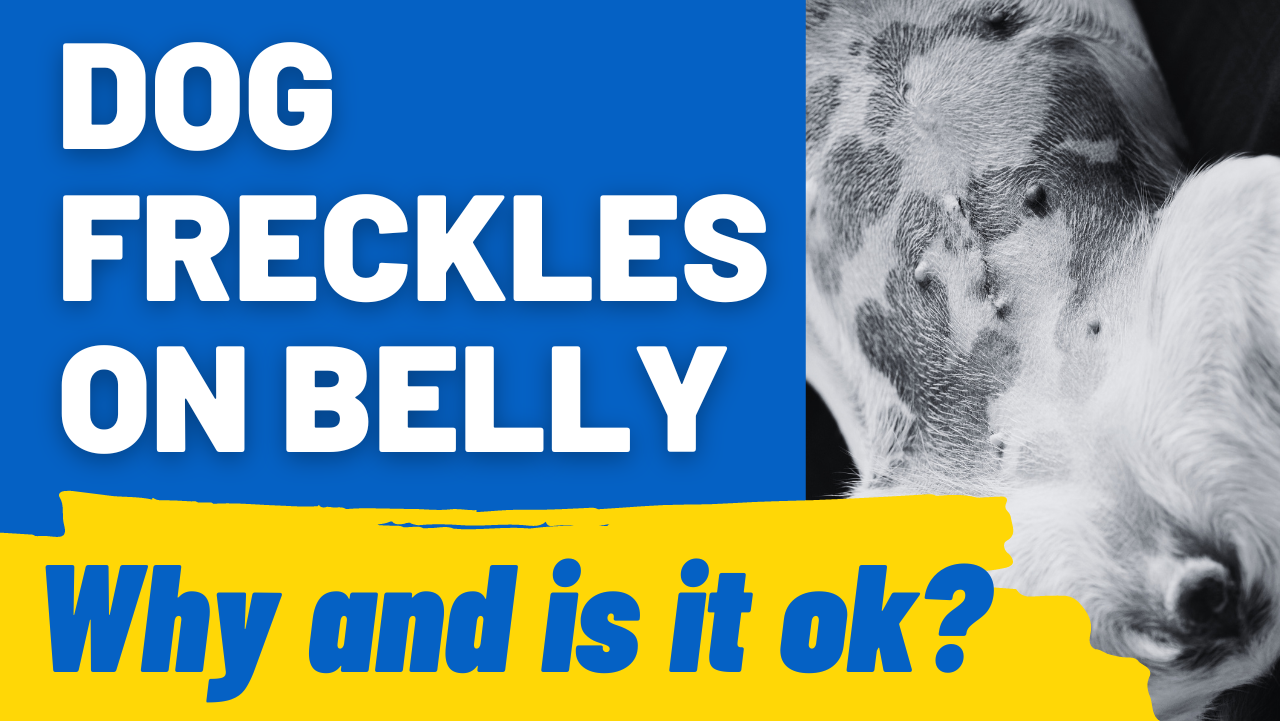Did your dog’s belly recently develop freckles, dark spots, or brown spots? Should you be concerned if your dog has freckles on their belly? Don’t worry! We came up with this dog freckles on belly Q&A to answer some of the most pressing questions you may have about it.
Why Does My Dog Have Freckles on Her Belly?
Freckles on a dog’s belly may be due to sun spots or age spots. These are relatively harmless to your pet.
1. Sunspots
Sunspots appear through the overproduction of melanin, a natural dark pigment in the skins of mammals. It’s like freckles in humans.
Melanin protects dogs from sun damage by absorbing UV light. It usually develops in areas of a dog’s body that aren’t covered by much protective fur, such as the belly.
Sunspots are natural and aren’t a big issue. However, if your pet is constantly exposed to sunlight, it could develop skin cancer.
Genetics also plays a role in the development of sunspots. According to the American Kennel Club, collies, bulldogs, dalmatians, and Australian sheepdogs are just some breeds that are susceptible to sun damage.

How to Prevent Sunspots
Like humans, dogs need sunscreen to protect themselves during outdoor trips. Select sunscreens that are zinc oxide and PABA-free as these can be dangerous to your dog!
A water-proof, unscented dog sunblock with SPF 30 should be enough. Apply it to areas with light pigmentation, such as the belly, inner thighs, ears, and the bridge of the nose. Make sure your dog doesn’t lick the sunscreen off as well.
2. Age Spots
Like sunspots, age spots happen through the excess buildup of melanin in the skin. The difference is, they form as your dog ages.
The flaw is more or less a natural occurrence. Age spots don’t hurt your pet.
You might like to also read our post, Puppy Dandruff and Dry Skin: Causes, Cures, and Treatments
What Are These Brown Spots on My Dog’s Belly?
Brown spots on your dog’s belly may be a sign of hyperpigmentation. This is when dark spots appear on the animal’s belly, legs, and groin. The spots may feel rough, thick, and velvety.
Hyperpigmentation isn’t a disease. It’s a minor result of another underlying issue or a reaction to the environment. That said, the real problem that’s causing hyper-pigmentation could be more serious.
Types of Hyperpigmentation
There are two types of hyper-pigmentation to look out for.
1. Primary Hyperpigmentation
Primary hyper-pigmentation can occur in all breeds. It’s the most popular among Dachshunds and Malteses that are over a year old.
It’s not curable but the problem may only be cosmetic. It won’t affect your dog’s health.
2. Secondary Hyperpigmentation
Secondary hyperpigmentation happens in all breeds. Labradors, German shepherds, terriers, dalmatians, and collies are the most susceptible.
In this case, the abnormality is triggered by allergies, hormonal imbalances, obesity, or contact dermatitis.
More often, it’ll lead to inflammation and spread towards the eyes, ears, and near the anus. If there’s itching and fluid discharge, you’ll have to see the vet immediately.
How Do Vets Diagnose Hyperpigmentation?

To find out what the cause of the abnormality is, your vet will have to conduct several tests.
First, your veterinarian will conduct a physical exam and medical history review. He’ll take skin scrapings to rule parasites out.
Next, the vet may conduct an allergy test and an endocrine function test to check for thyroid disease or hormonal imbalance.
Lastly, he’ll check for seborrhea through a skin biopsy.
Hyperpigmentation Treatment
Your vet may give you medicated shampoo to help in the removal of excess oil from the skin. Use it on your dog two to three times a week.
Depending on the disease that’s causing the hyperpigmentation, your vet may administer antibiotics to your dog.
Hyperpigmentation treatment can cost you upwards of $500 and it’ll take months for your dog’s skin to return to normal.
Why Does My Dog Have Dark Spots on His Belly?
If there are dark spots on your dog’s belly, this could be an early sign of a yeast infection.
Yeast colonies initially appear as small dark spots. The spots may grow and spread throughout your pet’s belly, inner thighs, groin, armpits, tail, and ears.
As the infection develops, your dog’s skin will turn reddish, dry, and itchy. Your pet’s fur may become greasy and start falling out. Moreover, a pungent smell or mange may start to appear.
An infection of the ear is more serious as it can lead to hematoma. If your dog develops this, fluid collects inside the ear. There’s no treatment for hematoma aside from surgery.
Causes of Yeast Infection
Yeast infection is a common occurrence in dogs. Yeast is naturally present in the skins of dogs. However, the yeast colonies may multiply if your dog has a weak immune system, to begin with.
Another cause could be antibiotic medication. If your pet gets prescribed antibiotics due to other diseases, the medicine may affect beneficial bacteria on the skin.
Yeasts aren’t affected by this medication. With the lack of competition, they’ll start to take over.
How to Treat Yeast Infection
The first thing you should do is take your dog to the vet for diagnosis. The vet will have to rule mange out, since some treatments for yeast infections may worsen it.
Next, the vet will prescribe an antifungal shampoo. A treatment like this may be slow as you’ll have to bathe your pet twice a month for three months. Oral antifungal medication may also work.
If you don’t have a big budget, you can use neem extract or apple cider vinegar as an alternative. Dilute them in water and spray them on the affected area. Wait for it to dry on the skin.
Lastly, improve your dog’s diet. Since yeast infections happen to immunocompromised dogs, multivitamins and a healthy diet can boost your dog’s immunity. Feed them healthy food that’s low in sugar.
Are the Dark Spots on My Dog’s Belly Freckles, Moles, or Something Else? Should I Be Concerned?
The dark spots on your dog’s belly may be freckles caused by sun spots, or age spots.
However, there may be an underlying issue like secondary hyperpigmentation or a yeast infection.
Dogs don’t normally have moles, but they could have impetigo, which may look like moles.
Impetigo or blackheads form when there’s a blockage on the sebaceous duct in the dog’s skin. They appear as black dots and may sometimes swell and become reddish.
It’s rarely fatal to dogs but it may lead to infections that can cause discomfort.
How to Treat Impetigo
There are topical and medicated shampoos that can treat impetigo in dogs. Moreover, you may make a 3% hydrogen peroxide solution or use tea-tree oil to spray on the affected area.
Don’t forcefully scrub the impetigo away! You can cause inflammation and even spread the problem.
Probiotic supplements may work as a treatment, but it’s best to consult your veterinarian.
Should You Become Concerned About Dark Spots?
Spots on your dog should always be a concern. However, there’s no need to panic! Just visit your nearest vet to have them diagnose the issue.
To Summarize
There may be many reasons for dark spots on dogs.
Age, sunlight, genetics, and diseases may all contribute to the issue. It’s necessary to have your vet examine your dog and ask him for a treatment plan.
Hopefully, our dog freckles on belly Q&A answered some of your questions and helped you decide what to do next!
Do you want to read our post, German Shorthaired Pointer: Dry Skin Care




